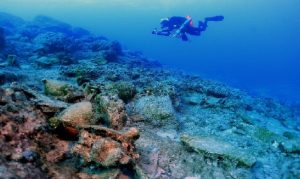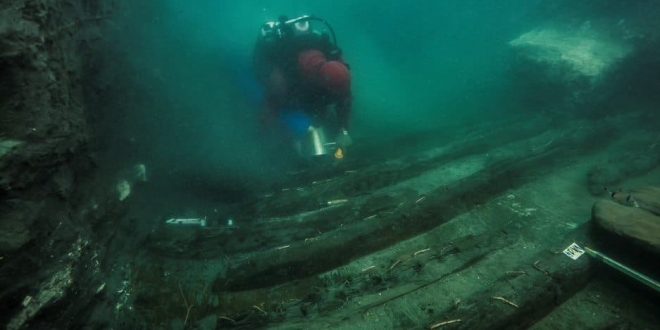22-07-2022
ATHENS: A shipwreck with ancient Greek treasures dating back to the Ptolemaic era of Egypt was recently discovered in the waters off Alexandria.
 The announcement was made by the European Institute for Underwater Archaeology (IEASM), led by researcher Franck Goddio.
The announcement was made by the European Institute for Underwater Archaeology (IEASM), led by researcher Franck Goddio.
Located in the Bay of Abou Qir, in the sunken, lost ancient city of Heracleion, or Thonis, near Alexandria, the shipwreck is from a time when the Greek civilization enjoyed great influence in Egypt in the waning days of the pharaohs.
Goddio states in a press release that the ship sank after being hit by huge blocks from the temple of Amun, which was totally destroyed during the cataclysmic event that occurred in the second century BC.
The ship had been moored at a wharf in the canal that flowed along the south face of the temple when the disaster occurred. The fallen blocks actually protected this ancient Greek shipwreck by pinning it to the bottom of the deep canal, which was then filled with clay and the debris of the sanctuary. The shipwreck lies under five meters (15 feet) of hard clay, mingled with the remains of the temple.
 Almost miraculously, the ancient Greek ship was only detected through the use of a cutting-edge sonar prototype called a “sub-bottom profiler.”
Almost miraculously, the ancient Greek ship was only detected through the use of a cutting-edge sonar prototype called a “sub-bottom profiler.”
“The finds of fast galleys from this period remain extremely rare,” explains Goddio, “the only other example to date being the Punic Marsala Ship from 235 BC.”
“Before this discovery, Hellenistic ships of this type were completely unknown to archaeologists,” he declares. “Our preliminary study shows that the hull of this galley was built in the Classical tradition and relied on long mortise-and-tenon joints and well-developed internal structure.”
“However, it also contains features of ancient Egyptian construction and allows us to speak of a mixed type of construction,” says Goddio. “It was a rowing ship that was also furnished with a large sail, as shown by a mast step of considerable dimensions. This long boat was flat-bottomed and had a flat keel, which was quite advantageous for navigation on the Nile and in the Delta.”
 He further explains that: “Some typical ancient Egyptian shipbuilding features, together with the evidence for a reuse of wood in the ship, indicate that it was built in Egypt. With a length of more than 25 meters (82 feet) it had a length-to-breadth ratio close to 6 to 1.”
He further explains that: “Some typical ancient Egyptian shipbuilding features, together with the evidence for a reuse of wood in the ship, indicate that it was built in Egypt. With a length of more than 25 meters (82 feet) it had a length-to-breadth ratio close to 6 to 1.”
In yet another part of the ancient, lost city of Heracleion, a tumulus stretching alongside the northeast entrance canal revealed remains of a large Greek funerary area covered with sumptuous funerary offerings dating back to the first years of the 4th century BC, according to Goddio.
According to a diver, the staggeringly beautiful and well-preserved Greek vases the underwater archaeologist uncovered at the tumulus “beautifully illustrate the presence of Greek merchants and mercenaries who lived in Thonis–Heracleion, the city that controlled the entrance to Egypt at the mouth of the Canopic branch of the Nile.”
Ancient Egypt port a trade hub for Greek ships
 Heracleion, better known by its original Egyptian name, Thonis, and sometimes called Thonis-Heracleion, was an ancient Egyptian port city located 32 km (20 miles) northeast of Alexandria on the Mediterranean Sea.
Heracleion, better known by its original Egyptian name, Thonis, and sometimes called Thonis-Heracleion, was an ancient Egyptian port city located 32 km (20 miles) northeast of Alexandria on the Mediterranean Sea.
The remains of the ancient city are now located under Abu Qir Bay, currently 2.5 km off the coast, under just ten meters (30 feet) of water. A stele found on the site indicates that it indeed had been one single city known by both its Egyptian and Greek names.
Before Alexandria was even a glimmer in Alexander the Great’s eye, Heracleion enjoyed its glory days, as it served as the main port of entry into Egypt for all the many ships arriving from throughout the Greek world. Thonis-Heracleion was for centuries the largest port of Egypt on the Mediterranean before Alexander founded Alexandria in 331 BC.
Thonis was originally built on some adjoining islands in the Nile Delta. It was intersected by canals with a number of separate harbors and anchorages. Its wharves, fantastic temples, and tower-houses were linked by ferries, bridges, and pontoons.
 Shipwreck only one of the ancient Greek treasures
Shipwreck only one of the ancient Greek treasures
The city was an emporion, or trading port, and in the Late Period of ancient Egypt, it was the country’s main port for international trade and collection of taxes.
Greeks had been allowed to settle in the city during the late Pharaonic period, when they quickly gained prestige and standing in society.
Now, it is located under the sea, seven kilometers off the present coast of Egypt.
Several earthquakes, followed by tidal waves which triggered earth liquefaction events, caused a 110-square-kilometer portion of the Nile delta to completely collapse under the sea, taking with it the cities of Thonis-Heracleion and Canopus.
Both cities were rediscovered in blockbuster archaeological finds by the IEASM in 2000 and 1999, respectively.
In 2000, Goddio discovered the stunning remains of statues and a temple dedicated to the god Amun, or Heracles, that had succumbed to a series of earthquakes, tsunamis, and rising sea levels, and slipped beneath the waves not to be seen again for more than 2,000 years. (Int’l News Desk)
 Pressmediaofindia
Pressmediaofindia




